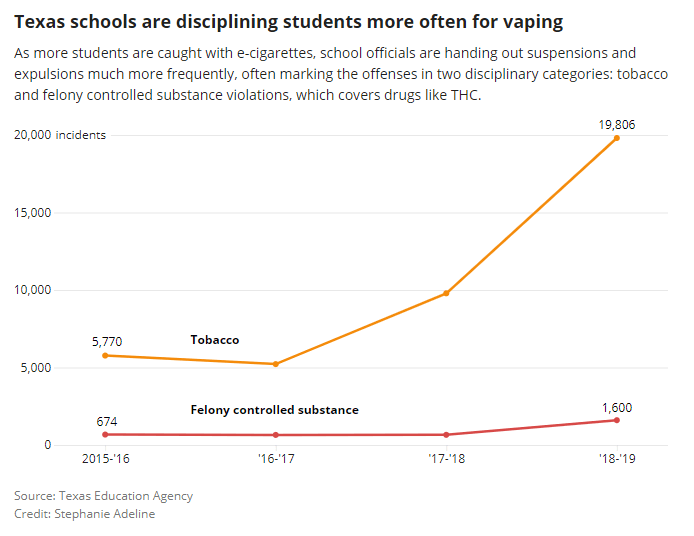
By SARAH DOOLITTLE, Four Points News
Although in some schools, vaping seemed to be waning prior to COVID-19, the facts continue to speak loudly. Across Texas, tobacco related violations in public schools reached some 20,000 incidents in the 2018-19 school year, according to the Texas Education Agency. Most of those incidents are tied to students vaping nicotine, TEA reports.
Earlier this year, local parents learned about the risks of students vaping through a program called “CATCH My Breath”. Mary Ann Kluga, coordinator of the Leander ISD Alcohol Drug Awareness and Prevention Team, presented “CATCH My Breath” at the invitation of the Four Points Middle School PTA on Feb. 27, prior to the COVID-19 pandemic.
CATCH is an acronym for Coordinated Approach to Child Health and its new anti-vaping initiative. It collaborated with researchers at Michael & Susan Dell Center for Healthy Living at The University of Texas Health Science Center at Houston School of Public Health to create CATCH My Breath. The evidence-based program is a youth e-cigarette, JUUL, and vape prevention program specific to grades 5-12.
CATCH my Breath has not yet been in wide use in LISD schools, but Kluga is offering the presentation to any LISD school or youth organization as a means of educating parents and students about the health, addiction and legal risks and consequences of vaping.
How it works
A vape pen works by heating up a vape liquid using a heating coil, called an atomizer, which turns the liquid into a vapor that the user inhales.
E-liquid
The e-liquids, as they’re called, contain a number of dangerous chemicals and are sold with or without nicotine or with THC (marajuana) in states where that is legal.
“Everybody thinks it’s water,” said Kluga. In truth, e-liquids contain “varying compositions of flavorings, propylene glycol, vegetable glycerin, and other ingredients,” according to the U.S. Food and Drug Administration’s website.
Though manufacturers of vape devices and e-liquids all claim not to market to children, Kluga showed parents that the packaging for various vape liquids looks almost identical to the packaging for candy and other kid-friendly food items.
Flavors
Though the U.S. government is currently working to regulate e-liquid flavors, they are still available to purchase in over 8,000 varieties, many of which are named after favorite candy and sugary beverage flavors.
Kluga also showed parents a number of vaping devices that looked like thumb drives or other innocuous items, and encouraged parents to carefully look through their children’s possessions if they suspect e-cigarette use.
Signs
Signs that a student may be vaping include: unusual online orders and packages arriving at home; a sweet smell on your child or your child’s possessions; increased thirst and nosebleeds; decreased caffeine use (vaping can cause an increased sensitivity to caffeine); the use of vaping lingo; and a change in appearance or behavior.
Risks
Besides the obvious health risks associated with inhaling heated chemicals, the risk of addiction to nicotine presents an almost greater danger, especially to those whose brains are still developing.
“Every time you do something your brain maps if you like it or not,” explained Kluga. “Nicotine starts rewiring the brain to work differently. So in the pleasure center in our brain… (nicotine) hoodwinks the brain into thinking that I need the substance for survival, not just for pleasure. So then if you don’t have it, you crave it.”
Because a young brain is so much more elastic, she said, it’s easier to lay those pathways for addiction, just like it’s easier for a child to learn another language.
That craving for nicotine can be very disruptive in an academic setting. “It interferes with learning,” explained Kluga. “It interferes with attention. It interferes with impulse control… Nicotine is a stimulant.”
Reduce usage
Broad efforts are currently underway to reduce the use of e-cigarettes by kids and adults.
A December 2019 bill was passed by congress raising the legal age for smoking, and the purchase of possession of vaping or any tobacco projects is now illegal under that age of 21.
LISD has strict tobacco and e-cigarette rules in place as well. A first violation for use or possession results in in-school suspension. A second violation means time at Leander Extended Opportunity campus or LEO.
As for how parents can discourage the use of such products, Kluga encouraged an open dialogue at home as well as parents also setting a good example.
She emphasized, though, the influence friends and classmates can have on student behavior. “Peer influence is probably the biggest thing and peer-led groups,” meaning that a kid with friends who vape is at a much higher risk for using.
Any groups wishing to learn more about vaping and the CATCH My Breath program can contact Kluga at maryann.kluga@leanderisd.org.

Vaping madness
By ALIYYA SWABY, JOLIE MCCULLOUGH Texas Tribune
Pitched as a way to help people quit tobacco, e-cigarettes heat nicotine-laced liquid, turning it into a vapor which delivers high concentrations of the drug straight into smokers’ lungs. But many of the actual consumers are young people, never before addicted to cigarettes, drawn to the colorful variety of flavors companies marketed. For more than a decade, federal officials have warned that e-cigarettes may be toxic and expressed concern that companies were targeting youth.
Juul Labs quickly cornered the teen market after popping up in 2015 with a sleek, inconspicuous vaping device and a long list of fruity flavors. More than 5 million teens across the country use e-cigarettes and the majority report that Juul is their brand of choice, according to a recent federal report.
With less public attention, vaping devices are also being used as a new alternative to smoking pot. Marijuana companies in states where the drug is legal have said vaping products now account for at least 30% of their business, according to The New York Times.
Officials’ health concerns were largely ignored until recently when vaping sparked a full-blown panic. Summer of 2019, the Centers for Disease Control and Prevention began investigating severe lung injuries and deaths in otherwise healthy people tied to vaping. More than 2,400 people had been hospitalized and at least 52 people died as of early December 2019. Last year, Texas accounted for more than 200 injuries and one death.
In Texas, almost all of the cases are tied to vaping THC oil and have involved youth.
“At this point, we’re really encouraging people, particularly young people, not to vape at all until we have a better handle on exactly what the cause is,” said Chris Van Deusen, a spokesperson for the Texas Department of State Health Services.
Committees of state lawmakers are looking into the public health effects and criminal consequences of vaping, considering how to deter people who are selling to teens. But guidance from the state, including the education agency, on how schools might best respond to teen vaping has been minimal. The gap in official communication prompted the Texas Association of School Boards to release its own guidelines for educators late last year.
“I’m very concerned that the approach we take with our young people and our school districts needs to be less nebulous and much more specific and much more aggressive,” state Sen. Beverly Powell, D-Burleson, said at a committee hearing late last year.
Legislators won’t be able to pass any new vaping laws until their 2021 session. But school officials are dealing with the issue now.
The Texas Tribune is a nonpartisan, nonprofit media organization that informs Texans — and engages with them – about public policy, politics, government and statewide issues.

